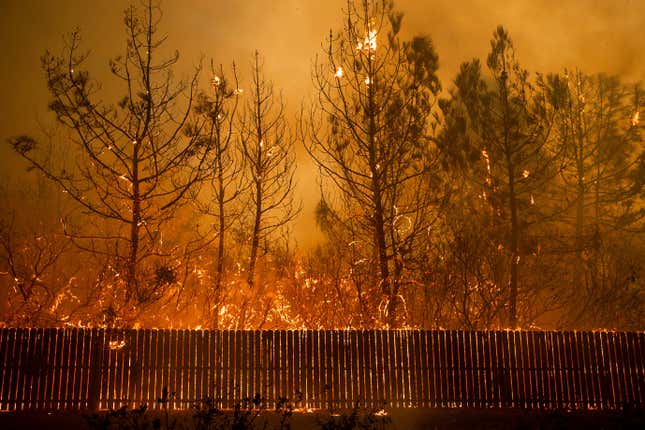
Nations are supposed to be doing everything they can to stave off catastrophic climate change, but a new report reveals that we’re not hitting the marks we need to. Not even close. We are speeding toward climate disaster, according to the report from the United Nations. Unless countries worldwide commit to much larger carbon emissions cuts, the planet is on track for between 2.1 and 2.9 degrees Celsius (3.8 to 5.2 degrees Fahrenheit) of average temperature increase by 2100. At that level of global warming, scientists forecast chaotic climate breakdown.
UN analysts assessed all of the current climate pledges from the nearly 200 nations that have signed onto the 2015 Paris Agreement. The researchers determined that those commitments leave us woefully far from the agreed-upon goal to limit warming to 1.5 Celsius (2.7 Fahrenheit).
To stay within that 1.5-degree goal, total greenhouse gas emissions need to fall 43% by 2030 compared with 2019 levels, according to the latest Intergovernmental Panel on Climate Change analysis. An earlier IPCC report determined we need 45% cuts by 2030 compared with 2010 levels.
But instead, based on existing plans, we’re headed toward a 10.6% increase in annual emissions by 2030 over 2010 levels. Compared with 2019 levels, our current national commitments put us at just a 0.3% emissions reduction by 2030.
“We are still nowhere near the scale and pace of emission reductions required to put us on track, said Simon Stiell, the executive secretary of the UN Climate Change, in a statement. “National governments need to strengthen their climate action plans now and implement them in the next eight years,” Stiell added.
What are countries doing?
Wednesday’s report comes less than two weeks before the start of the UN’s annual Climate Change Conference, known as COP 27. And it highlights one of the biggest limitations of the yearly gathering: Countries come together and make promises, but pledges like the Paris Agreement are non-binding, and leaders can simply opt to not follow through. At last year’s COP 26 in Glasgow, all of the 193 parties present agreed to revise and bolster their climate plans. Yet, only 24 did so, according to the UN.
“The fact that only 24 new or updated climate plans were submitted since COP 26 is disappointing,” Stiell said. “Government decisions and actions must reflect the level of urgency, the gravity of the threats we are facing, and the shortness of the time we have remaining to avoid the devastating consequences of runaway climate change,” he added.
Just four countries widely considered “developed” (Australia, South Korea, the United Kingdom, and Switzerland), submitted revised or updated climate plans since last year’s COP. Most of the 24 nations that did are in Africa or South and Central America, and the list includes island countries like Indonesia, Haiti, Vanuatu, and Dominica—which are all places projected to suffer disproportionately as climate change progresses.
Though this year the Unites States passed the most comprehensive climate policy it ever has with the Inflation Reduction Act, the U.S. didn’t pledge any further emissions reductions ahead of COP 27. And estimates say the IRA still only gets us about 80% of the way to our existing Paris Agreement promises.
What’s so bad about >2 C of warming?
We have already reached about 1.1 C (2 F) of warming since the start of the industrial age. And worldwide, humans are currently experiencing the effects of that climate change in our weather, food systems, ecosystems, and health.
With more warming, all of those existing impacts become more intense. Hundreds of millions of people will suffer from water and food scarcity. Tens of millions more would be displaced by sea level rise and severe weather. Extreme heat waves, for instance, would become about twice as common as they are currently, beyond 1.4 C (2.5 F).
Then, past 1.5 C, scientists forecast that Earth will cross many critical, irreversible, so-called climate “tipping points” that would catapult us even deeper into the climate spiral.
For example, at about 2 C (3.6 F) of warming, 99% of coral reefs die off. We lose large sections of the Antarctic Ice Sheet. The Amazon Rainforest dies back. We could lose nearly a million square miles of permafrost. Each of these things, in turn, exacerbates and accelerates climate change by releasing stored carbon and/or reducing the Earth’s ability to absorb greenhouse gases and reflect heat. If enough tipping points are reached, we might lose control of climate change entirely—the planet could become it’s own self-propelling runaway train.
And again, the UN is projecting that we’ll exceed 2 degrees Celsius of warming by the end of the century. I promise you, as a species, we don’t want that.
Is there any hope?
As long as there are people out there who care about the future, there will be hope. There is no absolute single tipping point past which we should all give up. Climate change is a matter of degrees, and it is always worth trying to minimize emissions and warming.
Even this week’s rather bleak UN report comes with a crumb of good news: Compared with last year, the numbers are better. That estimated 10.6% rise in emissions by 2030, from 2010 levels, is down from 13.7% in 2021, which “shows that nations have made some progress,” said Stiell. It proves national leaders can opt to take meaningful climate action, when faced with enough pressure. There is movement in the right direction, even if it’s not happening nearly fast enough. The solutions already exist; we just need to make our governments enact them.